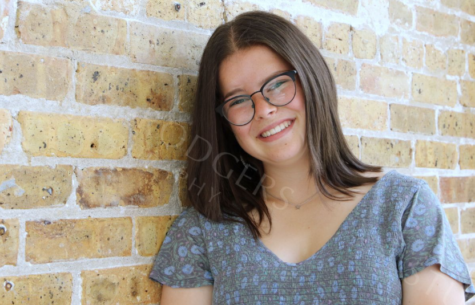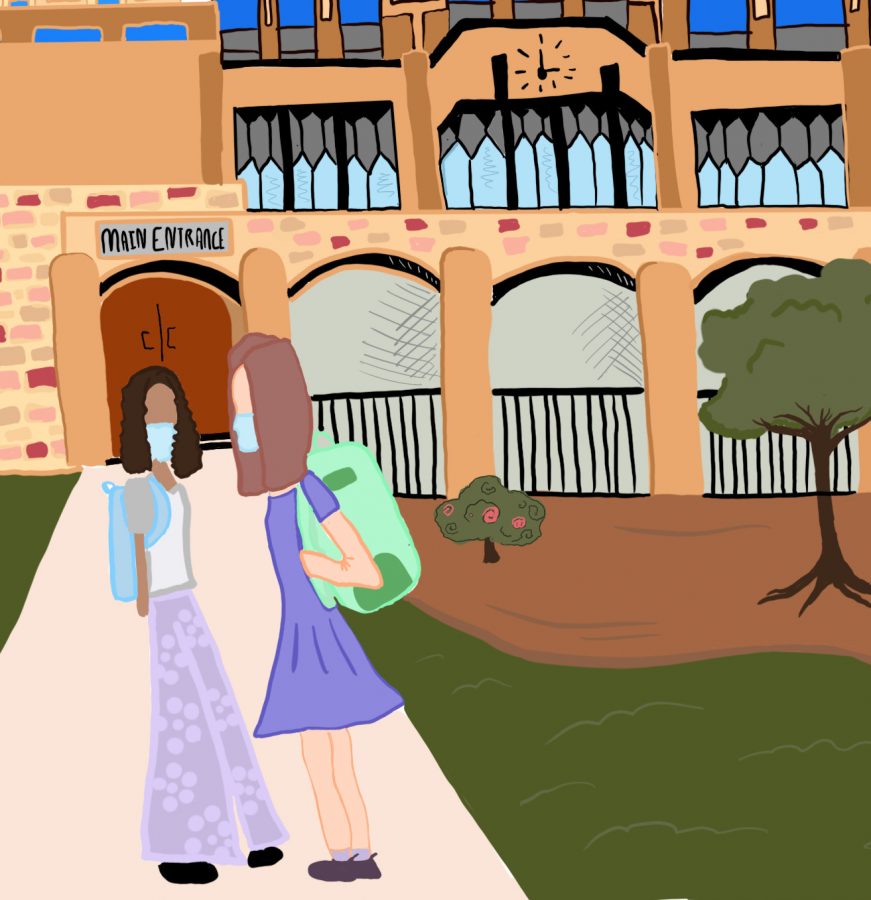Students, staff react to updated COVID-19 guidelines
As of Feb. 28, ETHS has moved to a “mask-recommended” model, meaning that masks are encouraged, but not required within the ETHS building. This decision comes as a result of multiple lawsuits that began in Sangamon County, Ill. In the original lawsuit in Sangamon County, the judge’s decision sought to override Governor J.B. Pritzker’s ability to mandate mask wearing in school settings.
This case worked its way up to the Illinois Supreme Court, where the jury declined to hear Pritzker’s motion to appeal the Sangamon County judge’s ruling against mask mandates. While the Illinois Supreme Court ultimately ruled in favor of Pritzker’s ability to mandate mask-wearing, Pritzker actually ended many widespread mask mandates, such as those in school settings, as of Feb. 28, 2022.
According to Rick Cardis, Teachers’ Council (TC) President and history teacher, ETHS’ decision to go mask-optional was announced at a staff meeting on Tuesday, Feb. 22. Cardis also explains that ETHS teachers and staff members were not given any official forum to express their opinions on ETHS’ new policy, raising legality questions among TC members.
“[It’s] disappointing that we weren’t given an opportunity to weigh in on timing,” Cardis says. “But also, [we have] legitimate concerns about the social and emotional wellbeing of our students as well as how it might affect instruction for these next few days. We actually believe that’s a violation of our contractual rights. Any changes to health and safety conditions at the school are things that we should have the opportunity to discuss, and we were not given that opportunity.”
Despite this frustration, Superintendent Eric Witherspoon says that ETHS was well poised to retire the mandate as it aligned both with current science and the governor’s recent orders.
“All of the changing rules in the state is what led to [going mask optional],” Witherspoon explains. “What we’ve done at ETHS is we’ve really closely adhered to the governor’s orders [and] the Illinois Department of Public Health. As that situation was changing, the IDPH rules were not extended. [On Friday, Feb. 25], the Illinois Supreme Court upheld the governor’s right to impose rules, [but] the very first thing he did was remove the rule, so it was absolutely the right time to continue going with the rules by the state.”
However, unlike ETHS, District 65 has opted to wait until March 7 to implement their mask-optional transition, a discrepancy that has caused confusion among staff and students. Some feel that having an extra week to prepare could have made ETHS’ transition to a mask-optional model smoother and less abrupt.
“On Friday [Feb. 18], I got an inkling that Dr. Witherspoon was considering doing away with masks, and my initial reaction was worried, because I felt like it was too fast,” Cardis says. “I felt like we could have used an extra week or two to prepare for the idea that it’s going to be mask optional and maybe to have a little more time to figure out how we’re going to take care of each other in the community.”
Within the walls of ETHS, many other students and teachers have also expressed concern about the school’s new stance.
“I don’t love the new guidelines. I was perfectly happy with the mask mandate. I felt safe with it. It was hard enough going back to school last fall. I had just gotten comfortable being in the building. Now, the uneasiness is going to start all over again. I want to feel safe in my school, and I don’t feel safe with the mask-optional announcement,” senior Izzy McDermott says.
Despite many students and staff members opting to continue masking, ETHS’ new changes may raise concerns for immuno-compromised students and staff members, as well as for individuals who live with immuno-compromised relatives.
“I don’t really like [the new guidelines],” freshman Annah Stevenson says. “I prefer to have masks because that makes me feel more safe about COVID. Especially without COVID numbers being pretty low, it just proves that the masks are working and I wish we could keep the mandate.”
While other students feel more comfortable with the transition to a mask-optional model, many students and staff have expressed concerns about the switch to bi-weekly COVID testing.
“The masks don’t bother me as much as I don’t understand why we’re going to the Shield testing every other week. Take off the masks, [but] let’s keep testing every week to see what the numbers are. That would make more sense to me,” English teacher Mariana Romano says. “That part of the decision I’m a little dubious about. I don’t understand why we wouldn’t just continue to test every week.”
According to Witherspoon, this change was also made to follow new science that supports this decision.
“The testing is, again, following the data we’re seeing,” Witherspoon explains. “If we start to pick up that the trend is [shifting], then we always have the option to test more people or test more often.”
Despite the range of emotions that students and staff are experiencing due to the changes at ETHS, many remain grateful that ETHS’ COVID cases are decreasing and that the school is moving towards a heightened sense of normalcy. Additionally, many teachers are figuring out ways to adapt to these changes and support their students in that process.
“We’re going to talk about [the changes] a little bit [in my classes], partly to encourage people who want to wear a mask that there’s still value in doing it and also to help other people see that maybe it’s better for other people if I [wear a mask],” Cardis says. “Hopefully, we [have] built enough of a community in my classes this year that we can have a discussion and try to chart a path forward. This is going to require a level of adaptation that we haven’t had to implement yet in the classroom, and I’m hopeful that everybody thinks big picture about taking care of one another and being respectful of one another whether they’re masked or unmasked.”
Your donation will support the student journalists of the Evanstonian. We are planning a big trip to the Journalism Educators Association conference in Philadelphia in November 2023, and any support will go towards making that trip a reality. Contributions will appear as a charge from SNOSite. Donations are NOT tax-deductible.














